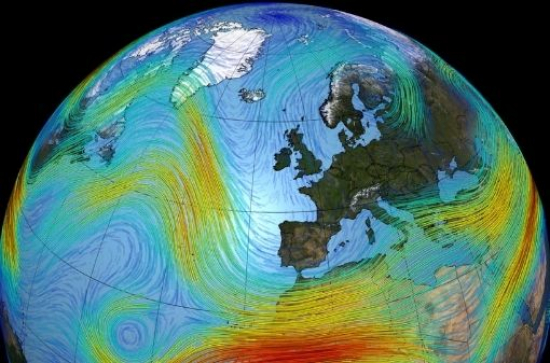
New research at Maynooth University’s ICARUS Climate Research Centre has found that the jet stream is moving northwards and increasing in speed, influencing storm activity and temperature patterns across the Northern Hemisphere.

Just this week, the jet stream brought storms Dudley, Eunice and Franklin to Ireland and the UK. Jet streams are fast bands of air which flow around the globe at around ten thousand metres above the Earth’s surface, and have a significant influence on storm activity and temperature patterns across the northern hemisphere which can impact the weather through strong winds and flooding events. This is the longest regional study of the northern hemisphere jet stream and research finds that the trends observed are potential indicators of climate change.
According to the study published this week in the peer-reviewed scientific journal, Climate Dynamics, provides a regional (land - ocean) comparison of the Northern Hemisphere jet stream, and finds that jet stream trends vary on a regional and seasonal basis. Between 1871 and 2011 the average winter jet stream latitude over the North Atlantic moved from 44° to 47° north with a 10 mph increase in speed to 132mph, but no increases were observed over the North Pacific.
The lead author of the paper, Dr Samantha Hallam, of the ICARUS Climate Research Centre at Maynooth University in Ireland, and the National Oceanography Centre in the UK, said:
“Significant increases in winter jet latitude and speed are observed over the North Atlantic and Eurasia which is consistent with the decreasing temperature and increasing pressure gradients observed between the equator and the Arctic over the period.
“Over the North Pacific, no increase in jet latitude or speed are observed, however, changes in the North Pacific sea surface temperatures explains over 50% of the variability in jet latitude.
“The results highlight that Northern Hemisphere jet variability, and trends differ on a regional basis. This is important for making climate predictions and in developing plans to combat climate change,” she added.
These findings are the result of a statistical analysis of the 250mb jet stream using the Twentieth Century Reanalysis dataset. The research was supported by the Marine Institute and funded by the Irish Government under the JPI Climate and JPI Ocean joint call and the Natural Environmental Research Council, and involved collaboration ICARUS Climate.
This project (Grant-Aid Agreement No. PBA/CC/20/01) is carried out with the support of the Marine Institute and funded by the Irish Government under the 2019 JPI Climate and JPI Oceans Joint Call.
Article available here https://link.springer.com/article/10.1007/s00382-022-06185-5
Image credits:
NASA's Scientific Visualization Studio
Trent L. Schindler (USRA): Lead Animator
Greg Shirah (NASA/GSFC): Visualizer
Horace Mitchell (NASA/GSFC): Visualizer
Laurence Schuler (ADNET): Project Support
Ian Jones (ADNET): Project Support
Original visualization can be found at: https://svs.gsfc.nasa.gov/4171
